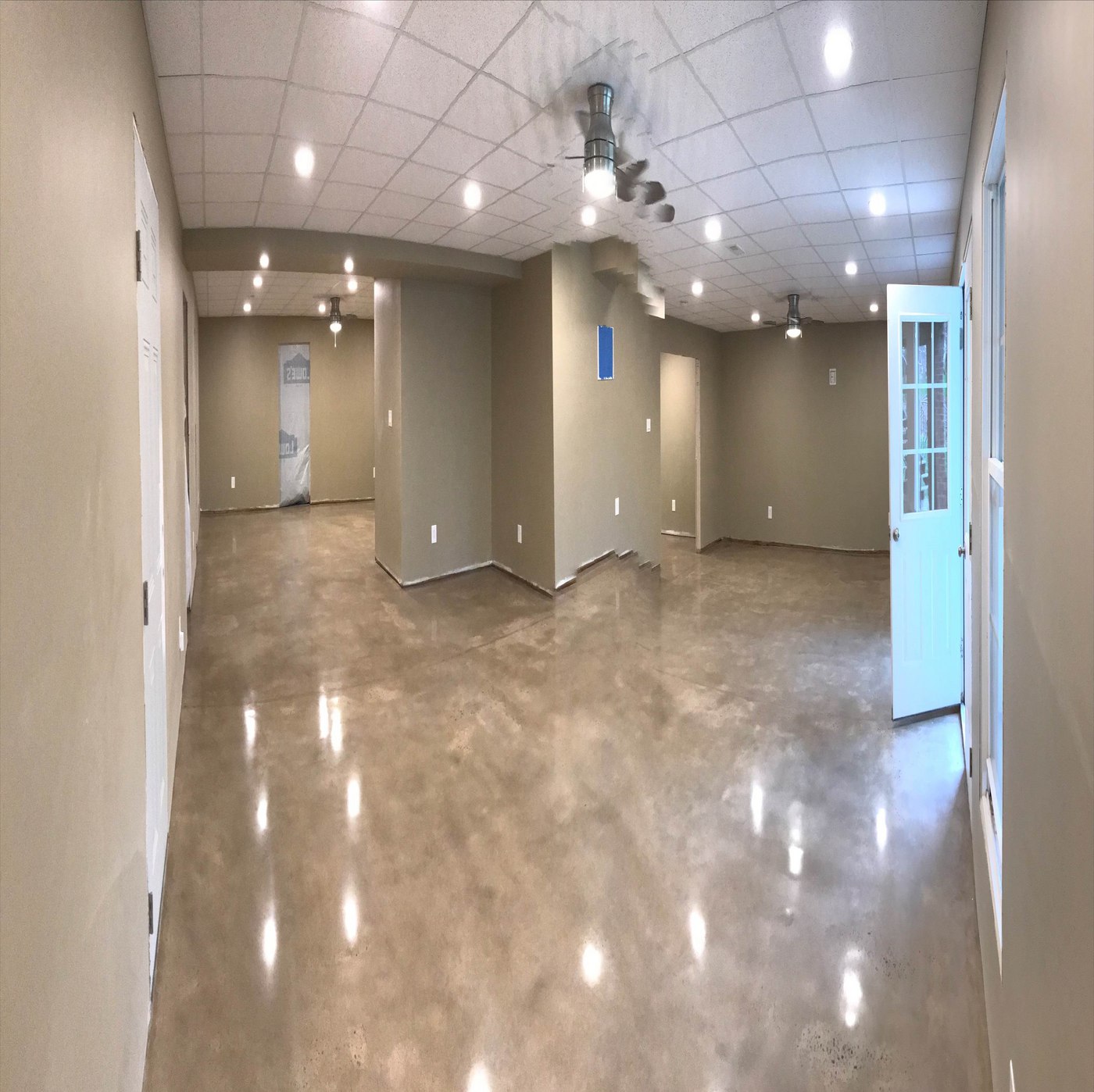posted by Custom Coatings, Inc. on April 6th, 2021
Concrete Polishing: Pros and Cons for Garage Floor Finishing
concrete coating | Concrete Polishing | garage floors | Residential Painting
So, you’ve got a concrete-floored garage (or basement) that’s in need of a little love. The floor kicks up dust, feels a little gritty and dirty no matter what you do to clean it, and you’d like the space to be a little nicer, a little more usable.
You’ve got a couple of traditional choices: a coated floor, spread with a durable epoxy layer is one option. But concrete polishing – a finishing method in which painting and coating professionals grind a bit off the top of your floor’s surface and then seal it – is an increasingly popular method for preserving and protecting concrete floors. We’ve been coating floors for more than thirty years, and polished concrete floors in homes have become one of the trendiest choices in the past decade.
Why is concrete polishing a great option for residential floors? It comes down to cleanliness, durability and cost.
Polishing keeps things clean.
Concrete is a crazy-durable, inexpensive, long-lasting flooring material. But it’s also a little…flaky. Ever noticed fine dust settling on your shoes, your car, or maybe your workbench after you’ve spent a bunch of time in your garage? If so, your concrete floor is likely unsealed. Unsealed concrete tends to “dust,” sloughing off particulates as its surface is scratched by shoes, car tires and equipment. When concrete is polished however, its pores are closed so that it no longer off-gases that dust.
For this reason, sealed concrete stays cleaner, keeping your workspace, man cave, storage area or machine shop (whatever you’re using your garage or basement for) clean as well, from the floor up.
There’s virtually zero chance of failure.
When you polish a concrete floor, you’re simply polishing the surface that exists and then applying an (often) clear penetrating sealant to the top. That means there’s really nothing there to chip away if something heavy drops on the floor or if a deep scratch happens. You’re simply only scratching away the top layer of the concrete itself.
So, we say that with polished concrete, there’s really nothing to fail. If you accidentally drop something sharp on your polished concrete floor and it creates a chip, the surface is “damaged” but nothing else will happen; the damage will stay contained to that area. On a coated floor however, if you scratch or gouge the coated surface, there’s a chance it will chip the coating itself, breaking its continuous surface and leaving edges that could continue to chip and flake away. In that case, your coating could fail if it’s gouged or scratched enough. With polished concrete, it just won’t happen.
Polished floors are stylish and unique.
We’ve noticed a trend toward polished residential concrete floors for years now, starting overseas in Europe. Today, Americans’ love of this slightly industrial look is just as strong. And it’s easy to see why: polished concrete highlights the beauty and uniqueness in every slab.
Depending on when your concrete was made, where it was made, and what materials were used in it, it will look entirely different than the next floor. Some older concrete tends to look beige, peach or even red when polished and sealed. Newer concrete tends to have a grey cast to it. Regardless however, all concrete looks a bit different and polishing and sealing enhances its natural color. But you can also bump the hue up even more with acetone dyes, which tint the concrete, covering stains and imperfections and creating a more unified but not entirely solid colored surface. Be sure to ask your painting professional about what your options are there; dyes come in just about any color you can imagine.
Cleanability is off the charts.
To say that cleaning and maintaining a polished concrete floor is easy is understatement. Think of it this way: many big-box retailers like Home Depot, Lowe’s and Sam’s Club use polished and/or stained concrete to line their warehouse store aisles. For them, it’s a no-brainer: someone will damage their floors. An employee with an over-full palette of toilets. A customer who’s lost control of something a little too heavy off the top shelf. A polished floor will hold up to this abuse without failure (see above), but also perform beautifully day after day, after quick mops with just soap and water.
That’s it. Soap and water is all it takes to keep your polished concrete floor sparkling and shiny for years and years to come. In warehouse stores, maybe a few years. In your home however, you can expect your floor to look great even a decade later if you take care of it.
Now that’s a great return on investment. And speaking of…
Polishing is inexpensive compared to other floor coatings.
Polished concrete is among the most economical flooring types out there.
In general terms (if you work with us, a decent sized floor, within moderate travel distance from our office without lots of repairs needed) will cost between $3 and $3.50 a square foot to polish and seal. Compare that to a coated floor, which can run between $5 and $7 a square foot.
Obviously other factors can alter the cost a bit. If your space is small, your price per square foot will be a bit more. If your concrete requires patching (which we can do, using an amazing polyuria compound that dries harder than your original flooring), cost for labor will increase as well. Just consider the numbers above a good starting point.
Get planning and get polishing.
One final note: you can walk into any DIY home improvement store and walk out with a rented concrete buffer and a gallon of sealant, but we wouldn’t recommend you do it. Why? You might get a good result, but more likely you’ll get a headache and a garage or basement that’s torn up for much longer than you’d bargained for.
Concrete polishing is one of those tasks that’s just best left to the pros (and is inexpensive enough to justify the cost of hiring someone to do it for you). Experienced painting and coating contractors have the professional equipment, the experience, and the process down cold on this type of work. (FYI: That cheap rental from Home Depot is only going to make a mess.) You might save a few bucks, but we also might end up with you as a customer anyway: the majority of the residential concrete sealing and coating jobs we do are re-dos and repairs made to floors where homeowners decided to DIY it. We’re happy to help, but would rather you not go through that pain to begin with.
So, looking for a clean, stylish floor that’s low on dust and even lower on hassle? Call the professionals at Custom Coatings to come out and polish your concrete. You won’t regret it.
Ready to get started sprucing up your garage or basement floor? We’re here to help. Contact us at info@customcoatingsinc.com or visit our website to fill out a contact form. Need more helpful tips and information on what we can do for homeowners? Check out our residential series on our blog, including articles about garage floor coatings and a comparison of floor coatings for your home.




